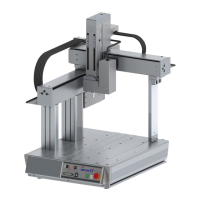Chapter 1 Specications Check1.2 Mechanical Specications
56
c) Cycle Time tc*
1) For Trapezoid Pattern
Assume the times for acceleration range and deceleration range as the acceleration time ta [s]
and deceleration time tb [s];
Acceleration/deceleration time ta(tb) =
(Set Velocity V [mm/s] / Acceleration / deceleration at operation α [mm/s
2
] ) [s]
Acceleration/deceleration movement distance Sa (Sb) =
(Acceleration / deceleration at operation α[G] x 9800 [mm/s
2
]) x
(Acceleration/deceleration time ta (tb) [s])
2
/ 2 [mm]
Constant velocity range movement distance S = Stroke St – Acceleration/deceleration movement
distance (Sa + Sb) [mm]
Cycle time tcr =
Constant velocity range movement distance S [mm] / Set Velocity V [mm/s] (for constant velocity
range) + Acceleration timeta [s] + Deceleration time tb [s] (for acceleration / deceleration range)
+ Positioning convergence time [s]
2) For Triangle Pattern
Acceleration/deceleration time ta (tb) =
√(Stroke St [mm] / Acceleration / deceleration at operationα [G] x 9800 [mm/s
2
])
Cycle time tct = (Acceleration timeta ta + Deceleration time tb) [s] + Positioning convergence time
[s]
d) Acceleration/Deceleration Time Ratio tod
1) Regardless of 1) Trapezoid Pattern or 2) Triangle Pattern;
Acceleration/Deceleration Time Ratio tod =
(Acceleration time at operation ta + Deceleration time at operation tb) / Cycle time tcr (tct)
e) Duty
Read the duty from the load factor LF figured out in b) and acceleration / deceleration time ratio tod.
e.g.) When the load factor LF = 80 [%] and acceleration / deceleration time ratio tod = 80[%], the
reference for the duty ration is 75 [%]. Set the operation point so the duty ratio be at or less
than this value.

